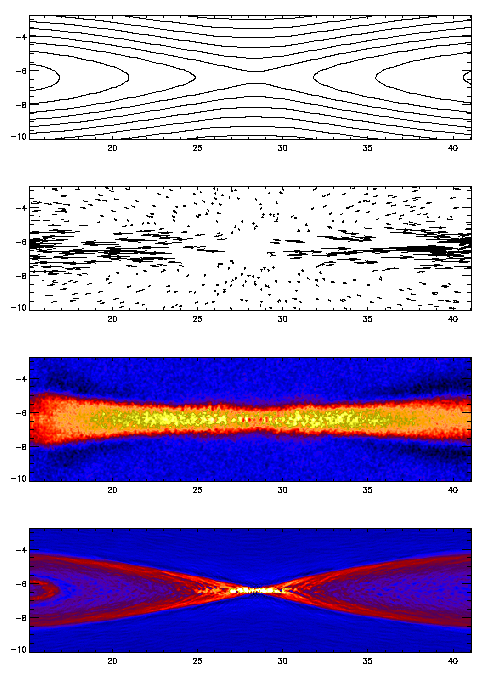|
MAGNETIC RECONNECTION Drake, Swisdak
Solar flares, storms in the earth's magnetosphere and disruptions in laboratory fusion experiments are examples of large scale explosive events which occur in plasma systems. The magnetic field is the source of free energy driving these phenomena. This magnetic energy can be released in locations where the magnetic field reverses direction. That is, the magnetic field can self-annihilate in these region and transfer its energy to plasma flows and intense, high energy beams. A major scientific challenge has been to explain the short time scales of this energy release. It is well established that the magnetic energy is released by magnetic reconnection, in which magnetic field lines in opposing directions cross link, forming a topological x-line. The topological change in the magnetic field required to form the x-line requires a breakdown in the ideal "frozen-in" flux condition, which occurs at small scales. As a result, magnetic reconnection occurs in narrow boundary layers. This topic is considered to be one of the two or three most important topics in plasma physics over the past thirty years because it occurs in so many varied environments and because the dependence of a large-scale, explosive phenomenon on the kinetic behavior at small scale has intrinsic interest. Key discoveries in magnetic reconnection made center around the role of whistler waves in driving and controlling magnetic reconnection. Traditionally it was believed that the Alfven wave played the key role in driving reconnection. At small scales, however, electron and ion motion decouple and the dynamics is controlled by whistler waves. The whistler waves fundamentally alter the reconnection process, causing the release rate of magnetic energy to be insensitive to the mechanism which breaks the frozen-in condition. The figure on the right shows the results of a computer simulation of magnetic reconnection. From top to bottom are the magnetic field lines, the plasma flows, and the ion and electron currents.
This research is supported by the National Science Foundation and the National Aeronautics and Space Administration.
|
 Two articles were published in April 2003 regarding work done by our research team on magnetic explosions. The first article appeared in
Two articles were published in April 2003 regarding work done by our research team on magnetic explosions. The first article appeared in